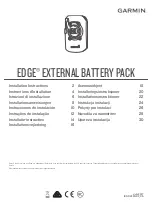
LTC1760
29
1760fc
For more information
www.linear.com/LTC1760
3.6.3 Current Limits When Charging Two Batteries
(TURBO Mode Enabled)
The following additional limits are applied to the charging
current algorithm described in 3.6 when charging two
batteries with turbo mode enabled:
a) The programmed current cannot exceed the maxi-
mum of the two requested cu I
LIMIT
. This
relaxed limit enables accelerated charging if I
LIMIT
is greater than the maximum of the two requested
currents. For the recommended matched battery
pair the requested current should be the same.
b) The programmed current cannot exceed I
LIMIT
TURBO mode provides a mechanism for the SMBus Host
to enable the charge MUX to apply additional current to
both batteries. TURBO mode only has an effect when two
batteries are being charged simultaneously. TURBO mode
does not affect wake-up charging or any other conditions
that could inhibit charging. TURBO mode is entered when
LTC(TURBO) is set high.
Normally the LTC1760 will limit the current into both bat-
teries to the maximum of the two requested cu
I
LIMIT
/32. TURBO mode removes this restriction, allowing
the charger to output as much as I
LIMIT
into the combined
battery system.
For example: In a system where LTC(TURBO)=0, I
LIMIT
=4.0A
and each battery is requesting 2A the LTC1760 will not
output more than 2.125A into the combined battery system
or 1.06A into each battery if their charge states match.
In a system where LTC(TURBO)=1, I
LIMIT
= 4.0A and each
battery is requesting 2A the LTC1760 will now output up
to I
LIMIT
into the combined battery system or 2A into each
battery if their charge states match.
Even without TURBO mode, the LTC1760 offers signifi-
cantly reduced charge times for matched batteries in the
top-off state. This time savings is especially significant for
Lithium-Ion batteries. Simultaneously charging two bat-
teries reduces losses in switches and improves efficiency.
3.7 Controlled Charging Voltage Programming
The LTC1760 monitors the requested and actual voltages
in each battery and increments the programmed voltage
by 16mV each t
QUERY
unless one of the following condi-
tions are met:
a) The actual voltage exceeds the requested voltage in
either battery.
b) The actual voltage exceeds V
LIMIT
.
This is an extremely important feature of the LTC1760 since
it allows the charger to servo on the internal cell voltage
of the battery as determined by the Smart Battery. This
voltage may be significantly lower than the battery pack
terminal voltage which is used by all Level 2 chargers.
The advantage for the LTC1760 is improved charge time,
safety, and a more completely charged battery.
The voltage correction cannot exceed the minimum re-
quested voltage by more than 512mV. When decrementing,
the programmed voltage is reduced by 16mV each t
QUERY
.
Whenever changing conditions cause either battery to stop
charging, the voltage algorithm is reset to zero.
4 System Power Management Algorithm and Battery
Calibration
4.1 Turning Off System Power
The LTC1760 allows the user to turn off system power using
the LTC(POWER_OFF) bit. When POWER_OFF is asserted
high all power management functions are bypassed and
the LTC1760 will turn off DCIN, BAT2 and BAT1 power
paths. This feature allows the user to power down the
system. Charging is still allowed when POWER_OFF is
asserted high.
4.2 Power-By Algorithm When No Battery is Being
Calibrated
The LTC1760 will always attempt to maintain system power.
The preferred configuration is to remain in 3- Diode mode.
In 3-Diode mode, power will be provided by BAT1, BAT2
and DCIN with the source at the highest voltage potential
automatically providing all the power. Sources at similar
voltage potentials will share power based on their capacity.
The following conditions will cause the LTC1760 to modify
its preferred power-by algorithm.
OPERATION
















































